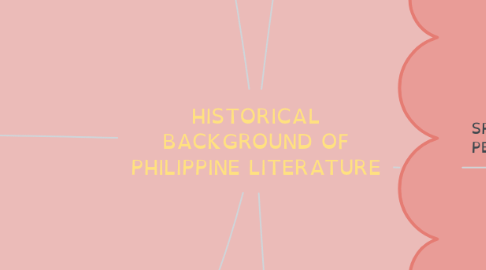
1. AMERICAN COLONIAL PERIOD
1.1. PERIOD OF APPRENTICESHIP
1.1.1. ENGLISH IS THE MEDIUM OF WRITING
1.1.2. SPANISH "SARSUWELA" WAS REPLACED BY "DRAMA"
1.1.3. REFINED IN THE CONTEXT OF CONTENT AND FORM
1.1.4. WOMEN HAVE THE OPPORTUNITY TO ENHANCE THEIR TALENTS
1.1.5. LITERARY FORMS
1.1.5.1. 1. SHORT STORIES
1.1.5.1.1. a. Dead Stars
1.1.5.1.2. b. The Key
1.1.5.1.3. c. Footnote To Youth
1.1.5.2. 2. NOVELS
1.1.5.2.1. a. Child of Sorrow
1.2. PERIOD OF EMERGENCE
1.2.1. INFLUENCED BY ROMANTICISM AND REALISM
1.2.2. LITERARY FORMS
1.2.2.1. 1. SHORT STORIES
1.2.2.1.1. most prevalent literary form
1.2.3. JOSE GARCIA VILLA WAS AWARDED THE TITLE "POET OF THE CENTURY"
2. JAPANESE OCCUPATION
2.1. WAR YEARS
2.2. SIMPLE LANGUAGE AND FREE VERSE
2.3. FICTION PREVAILED OVER POETRY
2.3.1. 1. 25 PINAKAMABUTING MAIKLING KATHANG PILIPINO
2.3.1.1. compilation of the short story contest by the military government
2.3.1.2. a. Suyuan sa Tubigan
2.3.1.3. b. Lupang Tinubuan
2.3.1.4. c. Uhaw ang Tigang na Lupa
2.3.2. 2. PERIOD OF MATURITY AND ORIGINALITY
2.3.2.1. Bountiful harvest in poetry, fiction, drama and essay
2.3.2.2. Filipino writers mastered English and familiarized themselves with diverse techniques
2.3.2.3. Literary “giants” appeared
3. CONTEMPORARY/ MODERN PERIOD
3.1. Martial Law repressed and curtailed human rights, including freedom of the press
3.2. Writers used symbolisms and allegories to drive home their message, at the face of heavy censorship
3.3. Theater was used as a vehicle for protest, such as the PETA and UP Theater
3.4. Writers continue to show dynamism and innovation.
4. PRE COLONIAL PERIOD
4.1. ORAL TRADITIONS
4.2. IDEOLOGY AND PHRASEOLOGY
4.3. BASED ON TRADITION REFLECTING DAILY LIFE ACTIVITIES
4.4. LITERARY FORMS
4.4.1. 1. ORAL LITERATURE
4.4.1.1. a. Riddles
4.4.1.2. b. Proverbs
4.4.1.3. c. Tanaga
4.4.2. 2. FOLK SONGS
4.4.2.1. a. Hele/ Oyayi
4.4.2.2. b. Ambahan
4.4.2.3. c. Kalusan
4.4.2.4. d. Tagay
4.4.2.5. e. Kanogan
4.4.3. 3. FOLK TALES
4.4.3.1. a. Myths
4.4.3.2. b. Legends
4.4.3.3. c. Fables
4.4.3.4. d. Fantastic Stories
4.4.4. 4. EPICS
4.4.4.1. a. Biag ni Lam-ang
5. SPANISH COLONIZATION PERIOD
5.1. RELIGIOUS VS. SECULAR
5.2. SPANISH IS THE MEDIUM OF COMMUNICATION
5.3. RELIGION BECAME AN IMPORTANT THEME
5.4. ROMAN ALPHABET REPLACED ALIBATA
5.5. LITERARY FORMS
5.5.1. 1. RELIGIOUS LITERATURE
5.5.1.1. a. Pasyon
5.5.1.1.1. long narrative poem about the passion and death of Christ
5.5.1.2. b. Senakulo
5.5.1.2.1. dramatization of the pasyon
5.5.2. 2. SECULAR LITERATURE
5.5.2.1. a. Awit
5.5.2.1.1. colorful tales of chivalry made for singing/ chanting
5.5.2.2. b. Korido
5.5.2.2.1. metrical tale written in octosyllabic quatrains
5.5.2.3. c. Prose Narratives
5.5.2.3.1. written to prescribe proper decorum
6. NATIONALISTIC/ PROPAGANA AND REVOLUTIONARY PERIOD
6.1. PLANTED SEEDS OF NATIONALISM
6.2. SPANISH LANGUAGE TO TAGALOG
6.3. ADDRESSED THE MASSES
6.4. LITERARY FORMS
6.4.1. 1. PROPAGANDA LITERATURE
6.4.1.1. a. Political Essays
6.4.1.1.1. Diaiong Tagalog
6.4.1.1.2. La Solidaridad
6.4.1.2. b. Political Novels
6.4.1.2.1. Noli Me Tangere
6.4.1.2.2. El Filibusterismo
6.4.2. 2. REVOLUTIONARY LITERATURE
6.4.2.1. more violent in nature than propaganda literature
6.4.2.2. a. Political Essays
6.4.2.2.1. helped inflame the revolution spirit
6.4.2.3. b. Kalayaan
6.4.2.3.1. newspaper edited by Emilio Jacinto
6.4.2.4. c. Poetry
